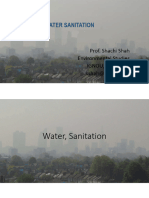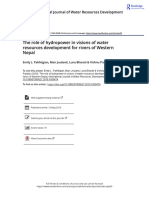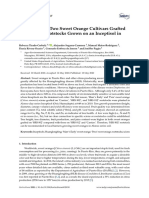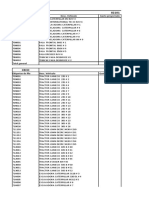0 ratings0% found this document useful (0 votes)
71 viewsJeevan Rijal Chhetri (R.C.) ASSISTANT PROFESSOR, Agricultural Economics. Campus of Live Sciences Tulsipur, Dang
Jeevan Rijal Chhetri (R.C.) ASSISTANT PROFESSOR, Agricultural Economics. Campus of Live Sciences Tulsipur, Dang
Uploaded by
Jeevan Rijal Chhetri- Nepal has abundant water resources but they are underutilized and irregularly distributed. Large agricultural areas rely on monsoon rains for irrigation, with only 20% of land benefitting from regular irrigation.
- While Nepal is considered rich in hydropower potential, it currently generates just over 700 MW and imports over 400 MW of electricity from India due to insufficient domestic generation.
- The government has implemented various policies, plans, and strategies to develop water resources for irrigation, drinking water, sanitation, hydropower, industry, and other uses. However, more than 20% of people still lack access to drinking water and water resources are not adequately managed or distributed.
Copyright:
© All Rights Reserved
Available Formats
Download as PPTX, PDF, TXT or read online from Scribd
Jeevan Rijal Chhetri (R.C.) ASSISTANT PROFESSOR, Agricultural Economics. Campus of Live Sciences Tulsipur, Dang
Jeevan Rijal Chhetri (R.C.) ASSISTANT PROFESSOR, Agricultural Economics. Campus of Live Sciences Tulsipur, Dang
Uploaded by
Jeevan Rijal Chhetri0 ratings0% found this document useful (0 votes)
71 views12 pages- Nepal has abundant water resources but they are underutilized and irregularly distributed. Large agricultural areas rely on monsoon rains for irrigation, with only 20% of land benefitting from regular irrigation.
- While Nepal is considered rich in hydropower potential, it currently generates just over 700 MW and imports over 400 MW of electricity from India due to insufficient domestic generation.
- The government has implemented various policies, plans, and strategies to develop water resources for irrigation, drinking water, sanitation, hydropower, industry, and other uses. However, more than 20% of people still lack access to drinking water and water resources are not adequately managed or distributed.
Original Title
NADP5.pptx
Copyright
© © All Rights Reserved
Available Formats
PPTX, PDF, TXT or read online from Scribd
Share this document
Did you find this document useful?
Is this content inappropriate?
- Nepal has abundant water resources but they are underutilized and irregularly distributed. Large agricultural areas rely on monsoon rains for irrigation, with only 20% of land benefitting from regular irrigation.
- While Nepal is considered rich in hydropower potential, it currently generates just over 700 MW and imports over 400 MW of electricity from India due to insufficient domestic generation.
- The government has implemented various policies, plans, and strategies to develop water resources for irrigation, drinking water, sanitation, hydropower, industry, and other uses. However, more than 20% of people still lack access to drinking water and water resources are not adequately managed or distributed.
Copyright:
© All Rights Reserved
Available Formats
Download as PPTX, PDF, TXT or read online from Scribd
Download as pptx, pdf, or txt
0 ratings0% found this document useful (0 votes)
71 views12 pagesJeevan Rijal Chhetri (R.C.) ASSISTANT PROFESSOR, Agricultural Economics. Campus of Live Sciences Tulsipur, Dang
Jeevan Rijal Chhetri (R.C.) ASSISTANT PROFESSOR, Agricultural Economics. Campus of Live Sciences Tulsipur, Dang
Uploaded by
Jeevan Rijal Chhetri- Nepal has abundant water resources but they are underutilized and irregularly distributed. Large agricultural areas rely on monsoon rains for irrigation, with only 20% of land benefitting from regular irrigation.
- While Nepal is considered rich in hydropower potential, it currently generates just over 700 MW and imports over 400 MW of electricity from India due to insufficient domestic generation.
- The government has implemented various policies, plans, and strategies to develop water resources for irrigation, drinking water, sanitation, hydropower, industry, and other uses. However, more than 20% of people still lack access to drinking water and water resources are not adequately managed or distributed.
Copyright:
© All Rights Reserved
Available Formats
Download as PPTX, PDF, TXT or read online from Scribd
Download as pptx, pdf, or txt
You are on page 1of 12
JEEVAN RIJAL CHHETRI (R.C.
)
ASSISTANT PROFESSOR, Agricultural Economics.
CAMPUS OF LIVE SCIENCES
TULSIPUR,DANG
Assistant Prof. Jeevan R.C.
Water resources, water management, plan, policy
and performance on water resources of Nepal
'Water is a precious gift of nature, essential for human [sic and other
creatures'] survival. Without water, life on earth cannot be sustained.
Water is required for basic human needs such as drinking, cooking and
bathing, for irrigation to grow crops, for hydropower to produce energy,
for industry and for the environment. Water is also inherent component
of the ecological chain on which all life and life-supporting systems
depend. In Nepal and other Himalayan Societies, water from the
mountains also has important cultural and spiritual significance.'
-Water Resources Strategy(WRC) Nepal 2002
Assistant Prof. Jeevan R.C.
• A longstanding myth puts Nepal at the top slot among hydropower rich
countries in the world, only next to Brazil. But nobody bothers to know how
much hydropower Brazil generates.
• In truth, Nepal is importing over 400 MW of electricity from India to end its
long hours of load shedding. The country generates just over 700 MW.
• Another myth makes Nepal noted for its riches in water resources. The
reality, however is large agricultural land relies on the erratic monsoon rains
for irrigation with only 20% land benefitting from regular irrigation facility.
• With the growing population, water demand has grown for religious and
cultural purposes as well. The diversion of water for irrigation and
hydropower has affected the rituals in the lower riparian belts. The
increased level of water pollution has also affected the lifestyle of the
people.
• More than twenty percent people are far from getting access to drinking
water.
Assistant Prof. Jeevan R.C.
• The National Water Resources Policy states ‘Even though the stock of
water resources overall is seen to be in abundance in Nepal, the resources
have not been made available in the appropriate quantity where and
when they are needed. It is certain that the pressure on this important
resource will increase in the coming years due to the likely scarcity of
water caused by the ever increasing population and climate change’
• The potentiality of water resource in Nepal is so huge that for Its efficient
and optimum usage would not only help Nepal to build a strong economy,
but could also substantially contribute to development of the countries of
the Ganga Basin.
Assistant Prof. Jeevan R.C.
Water Availability, its current Use and demand :
• An estimated annual runoff from the rivers (6,000 rivers and rivulets) of Nepal
'is 220 billion cubic meters, with an average annual precipitation of 1530 mm.
• Nepal has utilized mainly medium and small rivers for different uses such as
drinking water, irrigation and hydropower. The larger and perennial Himalayan
Rivers, except for a few run-of the-river schemes, have been virtually left
untapped.
• The total demand for water for domestic use, irrigation purpose , industrial
purpose, and generating hydro electric power (of which the last one is for non
consumptive purpose) in the year 2027 would be 98,980 million m3 compared
to 14,880 m3 in 2000 according to WRS.
Assistant Prof. Jeevan R.C.
Government policies, strategies and plans:
• The government has been following the sectorial approach to the
development of the water resources since the beginning of first five year
plan (1956).
• As such, the system of having separate chapters for different water
related subjects, such as energy, irrigation, drinking water and sanitation
etc. in the national periodic plans along with the long term plans, for
example, the Agriculture Perspective Plan (APP) 1995, the Irrigation
Master Plan 1990, the River Basin Master Plan (for example Koshi Basin
1985) etc. has been the practice.
• It was only in 1992 the government framed and implemented an
umbrella law for water, i.e. The Water Resources Act 1992. Based on its
features, this act can be called the first overall policy as well as a law on
water resources.
Assistant Prof. Jeevan R.C.
• As per its preamble the act was:
‘enacted to make arrangements for the rational utilization, conservation,
management and development of the water resources (surface water,
underground water or water in whatsoever form), and to make legal
arrangements for determining beneficial uses of water resources,
preventing environmental and other hazardous effects thereof and also for
keeping water resources free from pollution’
Assistant Prof. Jeevan R.C.
Specific objectives adopted for WRS include: (policy objectives)
• Help reduce the incidence of poverty, unemployment and under-
employment.
• Provide access to safe and adequate drinking water and sanitation for
ensuring health security.
• Increase agricultural production, ensuring the nation’s food security.
• Generate hydropower to satisfy national energy requirements and to allow
for export of surplus energy.
• Supply the needs of the industrial sector and other sectors of the economy.
• Facilitate water transport, particularly connection to a seaport.
• Protect the environment and sustain the biodiversity of natural habitat.
• Prevent and mitigate water-induced disasters.
Assistant Prof. Jeevan R.C.
Importance of water policy:
• For various reasons, the market mechanism cannot be expected to work perfectly
for water management and public policy must intervene in some form. From the
economist's point of view fixed cost for water system are typically high.
• Water is essential for consumption and production purpose
• Water policy is an important issue for environment economists because demand
and supply depends on so many technical and ecological parameters.
• Policy makers of France, Germany and Netherlands were among the first to use
the ecosystem approach to water resource policy.
• Water has been considered a free good.
• In many cases, ignorance about protection of water cycle, misuse, lack of
management and legal structures are the main cause of water scarcity or stress.
• Although water is scarce is some countries because of low rainfall, many of the
current water shortages are due to the lack of adequate policy, particularly with
respect to pricing. In some counties like Costarica, Laos, Nepal, rain is abounded
but water is scarce.
Assistant Prof. Jeevan R.C.
Assistant Prof. Jeevan R.C.
Thus, the policies and strategies seek:
• to make transparent arrangements for water sharing, based on evidence
and scientific analysis, among various users for the achievement of
maximum benefits from water resources in terms of drinking water,
irrigation, agriculture and animal husbandry, hydropower, industrial uses,
recreation and land navigation, and religious, cultural and environmental
use.
• The water resources shall be developed and managed as per the
integrated water resource management principles, by comprehensively
considering each basis in its entirety. Concerned basins will have water
transfer for the maximum economic, social and environmental benefits.
Assistant Prof. Jeevan R.C.
• Nepal's rivers contribute 45% of the Ganges annual flow, and 75% of the driest month's
average.
• It is estimated that the 200,000 million cubic meter annual runoff from Nepalese rivers is
underused and, at times, causes a severe, hazardous flood in Nepal, India and Bangladesh
(Still and Kirkby, 1991).
• Major rivers originate in the high Himalayas. There are three major river systems in Nepal,
namely, Koshi, Gandaki and Karnali. Each have several tributaries. The permanent shown
area and 80 glaciers on the high Himalayas make the largest rivers perennial.
• Nepal rivers are classified into three classes based on their origin.
• Rivers in class I originate in the high Himalayas above the snow line and have a sustained
dry season flow due to snow melt. The class II rivers originate below the snow line in the
slopes of the Mahabharat mountains which are perennial but have a low dry season flow.
• The class III rivers originate in the Siwalik ranges and southern slopes of the Mahabharat
mountains. These rivers are ephemeral and flashy with watersheds that are geologically
fragile, erodable and are deteriorating fast due to population pressure. Nepal's Terai belt
has rechargeable ground water potential, which occurs in both artesian and non-artesian
aquifers.
Assistant Prof. Jeevan R.C.
You might also like
- Water Resources Different Types Importance of Sources of Water 6d5bfa9aDocument12 pagesWater Resources Different Types Importance of Sources of Water 6d5bfa9ascribdfor7No ratings yet
- Presented By: " " Programmes, Reforms and Bharat NirmanDocument18 pagesPresented By: " " Programmes, Reforms and Bharat NirmanRahul Jaiswal0% (1)
- Water Governance in BangladeshDocument16 pagesWater Governance in BangladeshMuhammad ArifNo ratings yet
- 2024 Pew 3-4Document23 pages2024 Pew 3-4Mihir PrajapatiNo ratings yet
- Ecological Management of Rivers in India Jan 2012Document30 pagesEcological Management of Rivers in India Jan 2012Sudhit Sethi100% (1)
- Water Unit 1-NotesDocument35 pagesWater Unit 1-NotesEng Venance MasanjaNo ratings yet
- Water Management & Irrigation: XI FIVE YEAR PLAN (2007-2012) Vol. IiiDocument11 pagesWater Management & Irrigation: XI FIVE YEAR PLAN (2007-2012) Vol. Iiisatyam91No ratings yet
- Assignment On Water Policy of IndiaDocument21 pagesAssignment On Water Policy of IndiaAshutosh100% (2)
- D019851821 PDFDocument4 pagesD019851821 PDFDharma KrisnahadiNo ratings yet
- National Institute of Technology Uttarakhand 2014-15: Report On Imapcts of DamsDocument10 pagesNational Institute of Technology Uttarakhand 2014-15: Report On Imapcts of DamsRohit BansalaNo ratings yet
- Water PDFDocument7 pagesWater PDFPavan NandipatiNo ratings yet
- Chapter 1&2Document34 pagesChapter 1&2Lemma Deme ResearcherNo ratings yet
- Social Issues and EnvironmentDocument77 pagesSocial Issues and EnvironmentPrabhu Sharan SinghNo ratings yet
- Lecture 7 Social Issues and EnvironmentDocument64 pagesLecture 7 Social Issues and EnvironmentRahulNo ratings yet
- Report On Water Policy of PakistanDocument11 pagesReport On Water Policy of PakistanAli SherNo ratings yet
- Brief Profile Dakshina Pinakini River Rejuvenation ProjectDocument4 pagesBrief Profile Dakshina Pinakini River Rejuvenation ProjecttasmiyaNo ratings yet
- Akash-Rep-Rain Water Harvesting ReportDocument18 pagesAkash-Rep-Rain Water Harvesting ReportABHISHEK SALOTAGINo ratings yet
- Water Supply and Sanitation: An Overview: January 2011Document8 pagesWater Supply and Sanitation: An Overview: January 2011Henna KNo ratings yet
- Water PDFDocument8 pagesWater PDFShaikhsamiyanNo ratings yet
- Challenges of Urban Water Management in Nigeria THDocument11 pagesChallenges of Urban Water Management in Nigeria THOlusegun TolulopeNo ratings yet
- Assignment Environmental Science 08P701Document11 pagesAssignment Environmental Science 08P701Srinivasa RaghavanNo ratings yet
- Water Supply and Sanitation: An Overview: January 2011Document8 pagesWater Supply and Sanitation: An Overview: January 2011Prince NishadNo ratings yet
- Haxards Control - II by Prof. Shachi SahDocument30 pagesHaxards Control - II by Prof. Shachi Sahbirudulavinod1No ratings yet
- Draft National Water Policy 2012Document4 pagesDraft National Water Policy 2012Shaji MullookkaaranNo ratings yet
- The Role of Hydropower in Visions of Water Resources Development For Rivers of Western NepalDocument29 pagesThe Role of Hydropower in Visions of Water Resources Development For Rivers of Western NepalNeeraj BhattaraiNo ratings yet
- 2023-24 - Geography - 10-Notes Water - ResourcesDocument4 pages2023-24 - Geography - 10-Notes Water - ResourcesZoha AzizNo ratings yet
- National Water Policy 2002Document10 pagesNational Water Policy 2002Rajarshi MitraNo ratings yet
- Role and Status of Water in The Nepalese EconomyDocument8 pagesRole and Status of Water in The Nepalese Economythagunnaharish1232No ratings yet
- Kurukshetra: Water and SanitationDocument26 pagesKurukshetra: Water and SanitationPiyush OjhaNo ratings yet
- Chapter 5 Reporr TDocument19 pagesChapter 5 Reporr TMaryann Requina AnfoxNo ratings yet
- NWP 20025617515534Document10 pagesNWP 20025617515534pradipkbNo ratings yet
- s11269 011 9918 7 PDFDocument11 pagess11269 011 9918 7 PDFNadineNo ratings yet
- Water Supply and SanitationDocument62 pagesWater Supply and SanitationJhobs Besmonte50% (2)
- NRM Lect3 Water ResourcesDocument52 pagesNRM Lect3 Water ResourcesGRACE VERIDIANONo ratings yet
- Water Supply and SanitationDocument62 pagesWater Supply and SanitationGage Floyd BitayoNo ratings yet
- CHJBKDocument12 pagesCHJBKbabitasegar244No ratings yet
- Water Resources of HPDocument53 pagesWater Resources of HPDeepak PetwalNo ratings yet
- Equitable Water Resource Management: 'UN Decade On Ecosystem Restoration 2021-2030'Document15 pagesEquitable Water Resource Management: 'UN Decade On Ecosystem Restoration 2021-2030'sajid.ahmed4444No ratings yet
- Geography Class 12 Notes Chapter 16 Water ResourcesDocument7 pagesGeography Class 12 Notes Chapter 16 Water Resourceshc170156100% (1)
- Chap 08. Water Supply and Sanitation 30nov06 UPFDocument7 pagesChap 08. Water Supply and Sanitation 30nov06 UPFWI Eys To SeNo ratings yet
- Ten Most Salient Points Water in Nepal: Existing Water Collection/extraction InfractureDocument4 pagesTen Most Salient Points Water in Nepal: Existing Water Collection/extraction InfractureSaroj PhaijuNo ratings yet
- July 2022 Kurukshetra MagazineDocument17 pagesJuly 2022 Kurukshetra Magazinesangamesh mbNo ratings yet
- Water ManagementDocument12 pagesWater ManagementManoj NehraNo ratings yet
- Adopt A River Project OverviewDocument34 pagesAdopt A River Project OverviewRANJEET KUMARNo ratings yet
- Water EconomicsDocument10 pagesWater EconomicsAnjali anjuNo ratings yet
- Attachment Fodder Material For NABARD Grade A B Batch 1 Lyst8252Document17 pagesAttachment Fodder Material For NABARD Grade A B Batch 1 Lyst8252Deepak LohiaNo ratings yet
- Trends in Water Resources Development Projects in NigeriaDocument7 pagesTrends in Water Resources Development Projects in NigeriaRaji De Cypress OladapoNo ratings yet
- Chhattisgarh State Water Resources Development Policy, 2012: International Environmental Law Research CentreDocument13 pagesChhattisgarh State Water Resources Development Policy, 2012: International Environmental Law Research Centretech2piyushguptaNo ratings yet
- Principle of Irrigation For HorticultureDocument150 pagesPrinciple of Irrigation For HorticultureBekam BekeeNo ratings yet
- Towards Restoring Flows Into The Earth's Arteries: Why, What and How of Environmental Flows'Document30 pagesTowards Restoring Flows Into The Earth's Arteries: Why, What and How of Environmental Flows'Preetam Sundaray100% (1)
- Country Policy Support Programme (CPSP)Document27 pagesCountry Policy Support Programme (CPSP)Sravan KanigantiNo ratings yet
- Water For A Sustainable WorldDocument22 pagesWater For A Sustainable WorldAna MihaelaNo ratings yet
- Lecture 12 Water SustainabilityDocument19 pagesLecture 12 Water SustainabilityAlec LiuNo ratings yet
- Demand in the Desert: Mongolia's Water-Energy-Mining NexusFrom EverandDemand in the Desert: Mongolia's Water-Energy-Mining NexusNo ratings yet
- Rural Water Supply and Sanitation: Evaluation and Feasibility of WASH Development Projects in KenyaFrom EverandRural Water Supply and Sanitation: Evaluation and Feasibility of WASH Development Projects in KenyaNo ratings yet
- Pictorial Presentation of WASH Activities in Rural KenyaFrom EverandPictorial Presentation of WASH Activities in Rural KenyaRating: 5 out of 5 stars5/5 (1)
- Management and Environmental Dynamics of Lake and Reservoir FisheriesFrom EverandManagement and Environmental Dynamics of Lake and Reservoir FisheriesNo ratings yet
- Sustainable Water Management in Smallholder Farming: Theory and PracticeFrom EverandSustainable Water Management in Smallholder Farming: Theory and PracticeNo ratings yet
- Global Water Security: Lessons Learnt and Long-Term ImplicationsFrom EverandGlobal Water Security: Lessons Learnt and Long-Term ImplicationsWorld Water CouncilNo ratings yet
- Agricultural Water Management : Efficient Water Use in Crop ProductionFrom EverandAgricultural Water Management : Efficient Water Use in Crop ProductionNo ratings yet
- Portugal Geography History Encyclopedia Britannica 01Document27 pagesPortugal Geography History Encyclopedia Britannica 01Pinto da CruzNo ratings yet
- Objective Activities and Achievements Citrus Research Institute SargodhaDocument55 pagesObjective Activities and Achievements Citrus Research Institute Sargodhaanon_58150872150% (2)
- True or False AnswersDocument1 pageTrue or False AnswersMaisarahJaafarNo ratings yet
- Plant It, Grow It, Eat ItDocument42 pagesPlant It, Grow It, Eat ItSchool Vegetable Gardening100% (1)
- Impact of Climate Change On Water and Nitrogen Use Effi - 2020 - Agricultural WaDocument11 pagesImpact of Climate Change On Water and Nitrogen Use Effi - 2020 - Agricultural WanurhasanahanwarNo ratings yet
- SaynotocuteDocument6 pagesSaynotocuteMitch Angela Claire VillenaNo ratings yet
- What Is DeforestationDocument2 pagesWhat Is Deforestationdebo claroNo ratings yet
- Mulsa Organik: Pengaruhnya Terhadap Lingkungan Mikro, Sifat Kimia Tanah Dan Keragaan Cabai Merah Di Tanah Vertisol Sukoharjo Pada Musim KemarauDocument7 pagesMulsa Organik: Pengaruhnya Terhadap Lingkungan Mikro, Sifat Kimia Tanah Dan Keragaan Cabai Merah Di Tanah Vertisol Sukoharjo Pada Musim Kemaraunadine prameswariNo ratings yet
- Assessment of Two Sweet Orange Cultivars Grafted On RootstockDocument11 pagesAssessment of Two Sweet Orange Cultivars Grafted On RootstockAhmad Hassan ChNo ratings yet
- Plantas en Restos Arqueologicos de La Costa Central - Mark Nathan CohenDocument30 pagesPlantas en Restos Arqueologicos de La Costa Central - Mark Nathan CohenRoobert Martin Jimenez ReyesNo ratings yet
- Popular Kheti: Biofertilizers - Types and BenefitsDocument5 pagesPopular Kheti: Biofertilizers - Types and BenefitsmramagroNo ratings yet
- Crops Statistics of The Philippines, 2012-2016Document125 pagesCrops Statistics of The Philippines, 2012-2016Nicole S. ParanNo ratings yet
- BCM Agric GR 11 Weekly Test 10Document8 pagesBCM Agric GR 11 Weekly Test 10noncandaoyamaNo ratings yet
- Agri FisheryQ1Document39 pagesAgri FisheryQ1sanchezroman100% (2)
- Exempt Agricultural Building Frequently Asked Questions (FAQ)Document2 pagesExempt Agricultural Building Frequently Asked Questions (FAQ)Acho SamsuarNo ratings yet
- Barangay Governance Scorecard: 1.0 Cleanliness, Sanitation and HealthDocument22 pagesBarangay Governance Scorecard: 1.0 Cleanliness, Sanitation and HealthCharles DeanNo ratings yet
- 1 - The Migration of Scots N5 and HigherDocument19 pages1 - The Migration of Scots N5 and HigherUWU OWONo ratings yet
- Lentil VarietiesDocument5 pagesLentil VarietiesDavid MarkamNo ratings yet
- Region 2Document5 pagesRegion 2Ashlyn Shane MerencilloNo ratings yet
- Daily Lesson Plan in Technology and Livelihood Education 9 Agricultural Crop Production Week 2 Day 1 I. ObjectivesDocument8 pagesDaily Lesson Plan in Technology and Livelihood Education 9 Agricultural Crop Production Week 2 Day 1 I. ObjectivesMike Lyster AlvarezNo ratings yet
- Base para Programa de Reparacion 2021Document12 pagesBase para Programa de Reparacion 2021Alfonso Rodrigo ChiliquingaNo ratings yet
- BHIC 108 (English)Document190 pagesBHIC 108 (English)Gulfishan RahmanNo ratings yet
- Module 28 Reading Guide DoneDocument2 pagesModule 28 Reading Guide DoneMarvin HillNo ratings yet
- Uninformed and Disinformed Society and The GMO MarketDocument3 pagesUninformed and Disinformed Society and The GMO MarketAswad ZEllzNo ratings yet
- SDP - 10 - Sustainable Agriculture in IndiaDocument60 pagesSDP - 10 - Sustainable Agriculture in IndiavjvarNo ratings yet
- Effect of Hydrogel On Growth, Yield and Economics of Rainfed CastorDocument4 pagesEffect of Hydrogel On Growth, Yield and Economics of Rainfed CastorMadhu G ReddyNo ratings yet
- Selamawit TilahunDocument86 pagesSelamawit TilahuneyaNo ratings yet
- Soal Latihan Kelas 2 Bahasa Inggris 2014 2015Document2 pagesSoal Latihan Kelas 2 Bahasa Inggris 2014 2015Fara DinaNo ratings yet
- One Love Executive Business Plan 4Document62 pagesOne Love Executive Business Plan 4Rocio CarrascalNo ratings yet
- Tractor Financing SchemeDocument22 pagesTractor Financing SchemeAziz MalikNo ratings yet

























































































